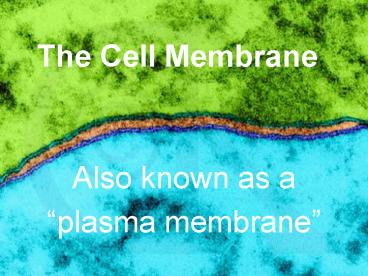The Cell Membrane - PowerPoint PPT Presentation
1 / 32
Title:
The Cell Membrane
Description:
The Cell Membrane Also known as a plasma membrane How does the cell membrane help regulate homeostasis? Made of phospholipids with embedded proteins. – PowerPoint PPT presentation
Number of Views:21
Avg rating:3.0/5.0
Title: The Cell Membrane
1
The Cell Membrane
- Also known as a
- plasma membrane
2
How does the cell membrane help regulate
homeostasis?
3
Made of phospholipids with embedded proteins.
- Phospholipid
- ?
4
(No Transcript)
5
- Cholesterol strengthens the cell membrane
- Proteins help materials cross the membrane, part
of the cytoskeleton - Carbohydrates help identify cell types
6
- Cell-surface marker identifies cell type
and identifies cells as self.
7
Intracellular receptor
- http//highered.mcgraw-hill.com/olc/dl/120069/bio0
6.swf
8
- Membrane receptor recognizes and binds to
substances outside the cell
9
Membrane receptors
- http//highered.mcgraw-hill.com/sites/0072495855/s
tudent_view0/chapter2/animation__receptors_linked_
to_a_channel_protein.html
10
- Transport protein Helps substances move
across cell membrane.
11
(No Transcript)
12
- Cellular Transport
- Sections 3-4 and 3-5
13
I. Passive Transport
- Materials move across membranes because of a
concentration gradient. - Does not require energy.
14
A. Diffusion
Diffusion is a type of passive transport.
- Molecules move from an area of high concentration
to an area of low concentration.
15
- Continues until equilibrium is reached
16
(No Transcript)
17
B. Osmosis
- How is osmosis different from diffusion?
- It only deals with movement of water
18
Three Types of Solutions
- Isotonic same concentration of dissolved
particles inside and outside of cell cell stays
the same size
- Hypertonic more dissolved particles outside
cell than in cell cell loses water and shrinks
- Hypotonic less dissolved particles outside cell
than in - cell cell gains water and swells
19
(No Transcript)
20
(No Transcript)
21
- Osmosis in Plant cells
- Hypertonic solutions result in plasmolysis
- (plasma membrane pulls away from cell wall)
22
23
- Practice Problem
- Sea water has a higher concentration of salt than
human body cells have. - Why might drinking large amounts of sea water be
dangerous for humans?
24
C. Facilitated Diffusion
- Facilitated diffusion is passive transport of
materials across the plasma membrane with the aid
of transport proteins . - Molecules such as sugars or amino acids enter
the cell through facilitated diffusion - Channel protein shown at right provides a
tubelike opening for small molecules
25
- Carrier proteins change shape to let larger
molecules into the cell
26
II. Active Transport
Cells use energy to transport materials against
the concentration gradient
27
Active Transport
- Active transport is powered by chemical energy
(ATP).
- Active transport occurs through transport proteins
28
Endocytosis
A cell can import large materials in vessicles
during the process of endocytosis.
- Cells use energy to transport material in
vessicles.
29
(No Transcript)
30
Exocytosis
- Exocytosis is the process of expelling material
from the cell.
31
Sodium-potassium pump
- http//highered.mcgraw-hill.com/sites/0072495855/s
tudent_view0/chapter2/animation__how_the_sodium_po
tassium_pump_works.html
32
(No Transcript)
33
(No Transcript)































